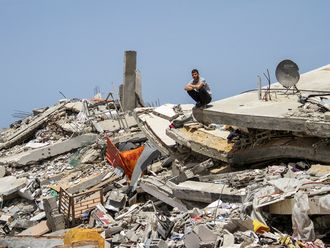Beirut: The apparent disintegration of a key Syrian rebel group has dealt a major blow to US efforts to build up a force of moderate fighters to take on Daesh.
The Hazm movement was seen as a cornerstone of the train-and-equip programme Washington hopes will bring thousands of non-extremist fighters to bear against Daesh in Syria.
But after suffering a devastating defeat at the hands of Al Qaida’s Syrian affiliate at the weekend, Hazm appears to have disbanded, with many of its fighters reported to have joined an Islamist coalition.
“The collapse of... Hazm means that, in effect, there is no substantial and credible Western-backed ‘moderate’ opposition throughout most of Syria,” intelligence consultancy The Soufan Group said in a brief.
On Saturday, Al Nusra launched a major assault on Hazm’s main operations centre - Base 46 in Aleppo province - which members of the group had seized from troops loyal to Al Assad in November 2012.
“Al Nusra kept pushing with heavy artillery and shelling for four to five hours,” Louay Meqdad, head of the Research Centre for Free Syrian Army Affairs and former spokesman for the FSA, told AFP.
In one night alone, he said, 73 Hazm fighters were killed.
Al Nusra overran the base and, according to the Syrian Observatory for Human Rights monitoring group, seized as many as 80 of the TOW missiles. Images circulated on social media showed Al Nusra fighters proudly brandishing their new weapons.
The next day, a statement from Hazm announced it was disbanding.
AFP could not independently confirm the statement’s authenticity but several fighters from the movement said via social media that they would be joining the Shamiyah Front, a large coalition of Sunni Islamist groups in Aleppo province.
“The collapse and self-dissolution of the Western-backed Harakat Hazm group... is a dramatic end to a group openly supported - to some degree - with Western military supplies and training,” The Soufan Group said.
Washington downplayed the incident, with a US military official telling AFP that Hazm’s apparent disbanding was a reminder “that Syria is a fluid battlefield”.
The official said the United States was resolved to its effort with moderate rebels, which aims to train about 5,000 Syrian fighters this year and roughly 15,000 over three years.
The United States is fully aware that “there will be losses of equipment and personnel,” the official said, adding that former Hazm members would be recruited for the programme, which is set to start in four to six weeks in Turkey.
“It’s a cautionary tale for all sides,” said Jeffrey White, defence fellow at the Washington Institute for Near East Policy, a think tank in the US capital.
White said that both sides of the programme will be spooked by Hazm’s disintegration and the snatching of its weapons by Al Nusra.
“It demonstrates for the US the risk of backing any one of these major groups” out of fear that distributed weapons will get into the hands of jihadists, White said.
And for the fighters themselves, he said, there will also be anxiety about receiving US support.
Another Western-backed rebel group, the Syrian Revolutionaries Front (SRF), has also faced repeated attacks from militant and lost territory in recent months.
“People who might go into that (programme) will look at the case of the SRF and Hazm and say: ‘Wait a minute, are these guys really going to stick with us, or will they expose us to retribution inside Syria?’” White said.












